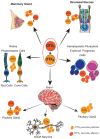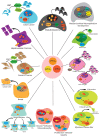OTX Genes in Adult Tissues
- PMID: 38069286
- PMCID: PMC10707059
- DOI: 10.3390/ijms242316962
OTX Genes in Adult Tissues
Abstract
OTX homeobox genes have been extensively studied for their role in development, especially in neuroectoderm formation. Recently, their expression has also been reported in adult physiological and pathological tissues, including retina, mammary and pituitary glands, sinonasal mucosa, in several types of cancer, and in response to inflammatory, ischemic, and hypoxic stimuli. Reactivation of OTX genes in adult tissues supports the notion of the evolutionary amplification of functions of genes by varying their temporal expression, with the selection of homeobox genes from the "toolbox" to drive or contribute to different processes at different stages of life. OTX involvement in pathologies points toward these genes as potential diagnostic and/or prognostic markers as well as possible therapeutic targets.
Keywords: OTX homeobox genes; adult tissues; inflammation; ischemia; tumor.
Conflict of interest statement
The authors declare no conflict of interest.
Figures




References
-
- Acampora D., Mazan S., Lallemand Y., Avantaggiato V., Maury M., Simeone A., Brulet P. Forebrain and Midbrain Regions Are Deleted in Otx2−/− Mutants Due to a Defective Anterior Neuroectoderm Specification during Gastrulation. Development. 1995;121:3279–3290. doi: 10.1242/dev.121.10.3279. - DOI - PubMed
Publication types
MeSH terms
Substances
LinkOut - more resources
Full Text Sources
Research Materials

